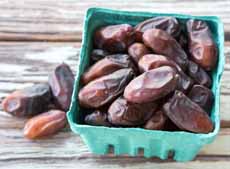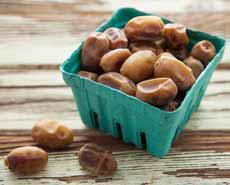TIP OF THE DAY: Know Your Dates
|
The first man-made candy was a taffy-like sweet made by cave men, who dried honey into chewy pieces.
But nature’s first ready-to-eat candy was the date. Figs may have been the first cultivated food (more about that below), but dates, which followed them, became the go-to candy. Wild dates are not edible, but early farmers discovered how to make the date palm bear sweet, succulent fruit. Honey, dates, figs and honey-coated nuts satisfied the sweet tooth for millennia. A premium date has the sweetness of honey crossed with sugar syrup. The flesh is soft and easily digestible. Its simple sugars—fructose and dextrose—replenish energy quickly (dates have been called “the world’s first energy snack”). Dates are as sweet as any dessert—but the sweetness is natural sugar (largely glucose and fructose), not refined sugar. With only 24 calories per date (248 calories per 3.5 ounce/100 gram serving), nutritious dates are as satisfying as empty-calorie candy and baked goods. They are high in dietary fiber and contain more potassium than bananas. They are virtually fat-free, cholesterol-free and sodium-free. And they contain an impressive number of vitamins. The science behind dates is also impressive. The fruit is loaded with different antioxidants that help with cholesterol, inflammation, eyesight and various cancers. As with any food, quality makes a big difference. There are luscious dates that are “food for the gods,” and sad, dried-out dates that at best should only be used for cooking and baking. If you can’t find good dates locally (we have this problem), you can buy them online. Nuts Online is a good source. You don’t need to mourn the sweet fruits of summer when you have a supply of good dates. And, as we’re close to Valentine’s Day, you have a good reason to make it a date. As with everything, there are different grades of quality. Go for the best. If your grocer doesn’t have the best, buy online. TYPES OF DATES Different date varieties ripen at different types during the season. The peak season for harvesting dates is mid-autumn through mid-winter (October through January in the U.S.). That means that a good variety is available now. Some varieties are chewier than others, some varieties are sweeter than others. But whatever the variety, look for plump, shiny dates and steer clear of those that are too sticky or covered with crystallized sugar. Most dates are sold with the pits in. To pit them for cooking, dust the blade of a paring knife with flour to minimize sticking. California’s Bard Valley, on California’s southeast border, is our nation’s date-growing capital. BARHI DATES: A small to medium size, barhi dates are nature’s caramel. The skin turns from amber to golden brown when the dates are cured. Sensual, velvety and syrupy-soft, a hint of vanilla gives them a caramel-like flavor. Add some mascarpone and you’ll have a dessert with flavor and texture extraordinaire. DAYRI DATES: A medium to large size, with a soft (as opposed to chewy) texture. Of all the date varieties, Dayri dates have one of the strongest, most quintessentially “date-like” flavors. They’re generally not as sweet as Medjool, so are an alternative for those who want a less sweet date. When fully ripe, the skin is brown to dark brown. |
[1] Barhi dates. [2] Dayri dates. [3] Khadrawi dates. [4] Medjool dates (date photos courtesy Good Eggs). [5] Dates grow in clusters at the top of the date palm tree (photo courtesy Dates Are Great). |
|
|
DEGLET NOOR DATES: Deglet Noor dates are chewy, medium-sweet, and substantial. They have a brown sugar sweetness, with rich, nutty overtones. They’re considered a dry date, giving them a longer shelf life and a more meaty texture great for tossing into salads. The variety is not sticky, so they’re good grab-and-go snacks. Those who generally don’t like dates should try them. HALAWI/HALAWY DATES: A small to medium date with bright golden brown skin and tender flesh, these soft dates are appropriately named: Halawy means sweet in Arabic. KHADRAWI/KHAWDRY DATES: Khadrawi dates have been called pudding-like. They would fit right in on a plate of chocolates. The medium to large fruits are not overly sweet. The skin is orange-brown to light-brown. These dates do not keep well, so need to be eaten fresh. MEDJOOL DATES: Medjool dates have a meaty, chewy texture with a strong, quite sweet flavor. The most common date variety grown commercially in California, a top-quality Medjool is large and pillowy. THOORY DATE: This sweet, nutty date is in the dry style. It is known as the “bread date” because it is qwll suited to baking. The medium to large fruit has golden-brown flesh. ZAHIDI DATES: Zahidis are a medium-size fruit with smooth, glossy, golden-yellow skin. It has a meaty, semi-dry texture that makes it good for snacking or baking. |
||
|
[6] Bacon-wrapped dates. [7] Fish with a date crust. [8] Dates in a grain dish (photos 6-8 courtesy Medjool Dates). [9] Date cake (photo courtesy Bestia LA). [10] Dates with honey syrup (photo courtesy Melissas). |
HOW TO ENJOY DATES
Just look for “date recipes” and you’ll find hundreds of ideas for breakfast, lunch, dinner and dessert. Serve chopped dates with breakfast foods to start the day with more energy. They’re delicious on hot or cold cereal and you can refrain from adding refined sugar. Or serve as a garnish for pancakes or eggs. More ideas: Archaeobotanists found evidence that the dawn of agriculture may have come with the domestication of fig trees in the Near East some 11,400 years ago—around 9400 B.C.E. This is roughly 1000 years before the domestication of the dietary staples wheat, barley and legumes. The discovery makes the fruit trees the oldest known domesticated crop (source). The date palm tree is believed to have originated in northern Africa. It was cultivated along the banks of the Nile River and throughout the Fertile Crescent, a crescent-shaped region containing the comparatively moist and fertile land of the otherwise arid and semi-arid lands of Western Asia*, the Nile Valley and the Nile Delta. Also known as the “cradle of civilization,” this area between the Tigris and Euphrates Rivers comprised the lands we now know as Iraq, small portions of Iran and Turkey, the Levantine coast of the eastern Mediterranean (Lebanon, Israel, Jordan, Syria and the West Bank) and Egypt’s Nile Valley. Here’s more on the first domesticated plants and animals. |
|
|
________________ *Western Asian comprises Anatolia, the Arabian peninsula, Armenian Highlands, Iran, the Levant, Mesopotamia, the Sinai Peninsula and the South Caucasus.
|
||









